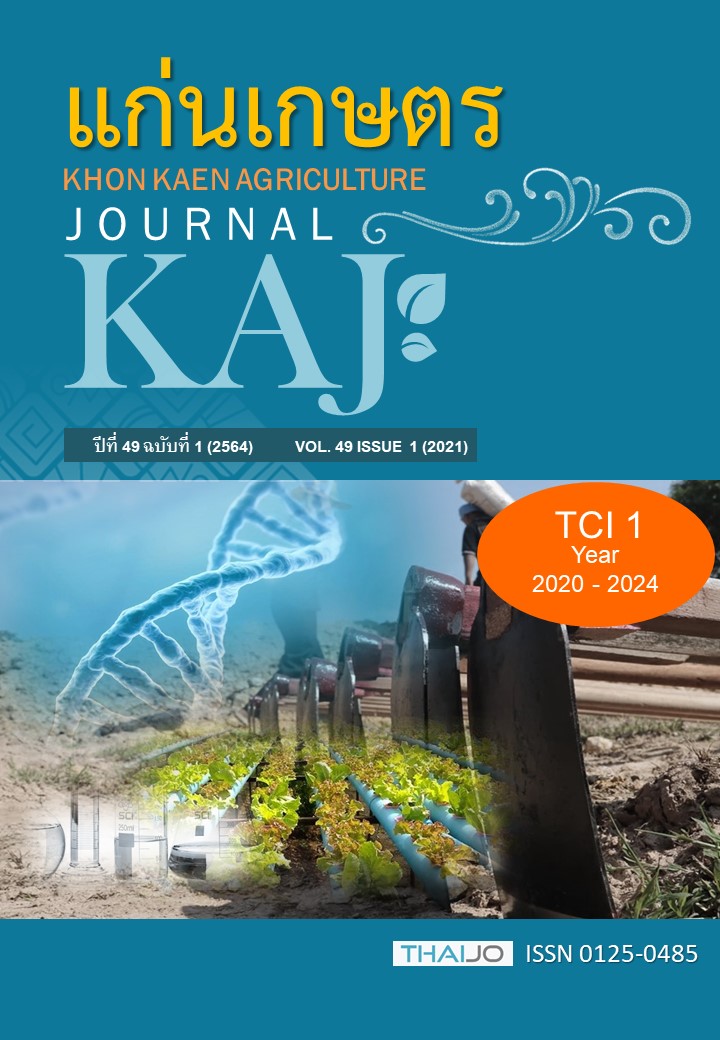Impacts of bioenergy on Thai agricultural sectors and households
Main Article Content
บทคัดย่อ
This study was conducted to analyze the impact of bioenergy policy on the agricultural sector and household income-groups in Thailand using the Computable General Equilibrium model (CGE), and estimate its welfare effect based on the compensating variation. This paper develops a CGE model to deal with the issue of ethanol and biodiesel policy on Thailand. In the long run, the ethanol and biodiesel policies had a positive impact on real GDP. Moreover, both policies had a positive effect on the agricultural sector, and appreciation of the baht led to more trade balance deficit. The ethanol and biodiesel policies had a similar effect on the export value, especially agricultural and agro-industrial exports. However, the compensating variation associated with the policies differed between household income groups, and the rich income groups benefitted more from the biofuel policy than the poor ones.
Article Details

อนุญาตภายใต้เงื่อนไข Creative Commons Attribution-NonCommercial-NoDerivatives 4.0 International License.
เอกสารอ้างอิง
Asafu-Adjaye, J., and S. Wianwiwat. 2012. A CGE approach to the analysis of biofuels for promoting energy self sufficiency and security policy in Thailand-Methodology. Procedia Engineering. 49: 357-372.
Boonpramote, T. 2017. Impact analysis of removing petroleum product subsidies in Thailand, in Han, P. and S. Kimura, Institutional policy and economic impacts of energy subsidies removal in East Asia. ERIA research project report 2015-23, Jakarta: ERIA, 33-60.
Chen, X., and M. Khanna. 2013. Food Vs Fuel: the effect of biofuel policies, American. Journal of Agricultural Economics. 95: 289-295.
Cui, J., H. Lapan, G. Moschni, and J. Cooper. 2011.Welfare impact of Alternative Biofuel and energy policies. Journal of Agricultural Economics. 93: 1235-1256.
Dodder, R. S., and O. P. Kaplan, A. Elobeid, S. Tokgoz, S. Secchi, and L. A. Kurkalova. 2015. Impact of energy prices and cellulosic biomass supply on agriculture, energy, and the environment: An integrated modeling approach. Energy Economics. 51: 77-87.
Elizondo, A., and R. Boyd. 2017. Economic impact of ethanol promotion in Mexico: A general equilibrium analysis. Energy policy. 101: 293-301.
Horridge, M. 2014. ORANI-G: A generic single-country computable general equilibrium model. Centre of policy studies and impact project, Victoria University, Australia, Available: http://www.usp.br/nereus/wp-content/uploads/oranig06.pdf. Access January 10, 2019.
Jafari, Y., and J. Othman. 2016. Impact of biofuel development on Malaysian agriculture: a comparative statics, multicommodity, multistage production, partial equilibrium approach. Food and energy security. 5(3): 192-202.
Kaenchan, P., S.H. Gheewala, and N. Puttanapong. 2016. Effect of ethanol development on Thailand’s economy SEE2016 in conjunction with ICGSI 2016 and CTI2016 on “Energy &climate change: innovative for sustainable future” 28-30 November 2016, Bangkok, Thailand
Kuma, S., P. Shrestha, P.A. Salam, and E. Ackom. 2013. An Assessment of Thailand’s Biofuel Development. Sustainability. 5: 1577-1597.
Ge, J., and Y. Lei. 2010. Assessing Welfare and Growth Effects of Grain-based Fuel Ethanol Development in China: A General Equilibrium Framework. Journal of convergence information technology. 5(10): 1-8.
Gerbregiorgis, B.M. 2015. The Economic Impacts of Maize-based Bioethanol Production in South Africa:A Social Accounting Matrix Analysis. Master Thesis. Swedish University of Agricultural science.
Gohin, A. 2008. Impacts of the European Biofuel Policy on the Farm Sector: A General Equilibrium Assessment. Review of Agricultural Economics. 30(4): 623-641.
Maipita, I., M.D. Jantan, Fitrawaty, and S. Narimo. 2012. The impact of diverting of fuel subsidy to agricultural sector on poverty. CMU Journal of Economics. 16: 391-424.
Ministry of Energy. 2018. Energy statistics of Thailand 2018 (Online). Available: https://drive.google.com/file/d/1WcNsEWr93CmhqQpMJMVbdHRNaQVwr_d4/view. Access January 10, 2019.
Mukhopadhyay, K., and P. J. Thomassin. 2011. Macroeconomic effects of the ethanol biofuel sector in Canada. Biomass and Bioenergy. 35(7): 2822-2838.
NESDB, 2012. The 2010 Input-Output Table of Thailand. National Economic and Social Development Board, Bangkok, Available:https://www.nesdb.go.th/ewt_news.php?nid=5705&filename=io_page.Access January 10, 2019.
Okiyama, M., and S. Tokunaga. 2010. Impact of expanding bio-fuel consumption on household income of farmers in Thailand: Utilizing the computable general equilibrium model.review of urban®ional development studies. vol.22 no.2/3
Patton, M., J. Binfield, S.I. Kim, L. Zhang, and J. Davis. 2012. Linkage between the energy, biofuel and agricultural sectors. 86th Annual Conference, April 16-18, 2012, Warwick University, Coventry, UK 134717, Agricultural Economics Society.
Renner, S., J. Lay, and H. Greve. 2016. Household Welfare and Co2 Emission Impacts of Energy and Carbon Taxes in Mexico. Green Growth Knowledge Platform, Korea.
Silalertruksa, T., A.H. Gheewala, K. Hunecke, and U.R. Fritsche. 2012. Biofuels and employment effects: Implications for socio-economic development in Thailand. Biomass and Bioenergy. 46: 409-418.
Tiezzi, S., and S.F. Verde. 2016. Differential demand response to gasoline taxes and gasoline prices in the U.S. Resource and Energy Economic. 44: 71-91.
Timilsina, G.R., J.C. Beghin, D. van der Mensbrugghe, and S. Mevel. 2012. The impacts of biofuels targets on land‐use change and food supply: A global CGE assessment. Agricultural Economics. 43: 315-332.
Wianwiwat, S., and J. A. Adjaye. 2013. Is there a role for biofuels in promoting energy self sufficiency and security? A CGE analysis of biofuel policy in Thailand. Energy Policy. 55: 543-555.
Wu, J., and C. Langpap. 2015. The price and welfare effects of biofuel mandates and subsidies. Environment Resource Econ. 62: 35-57.


